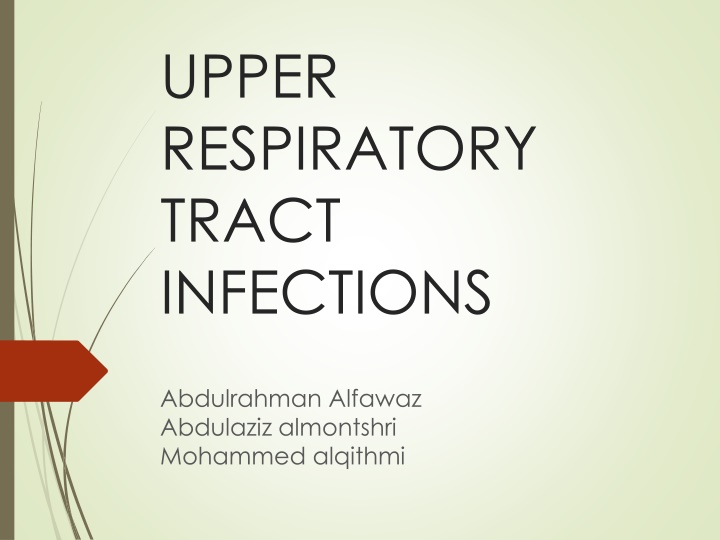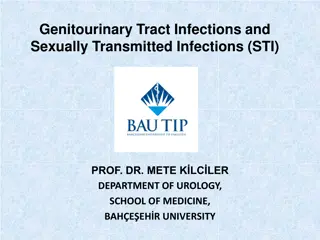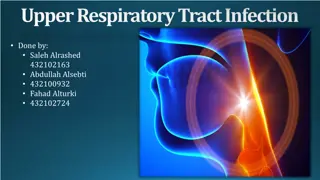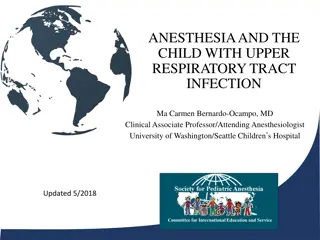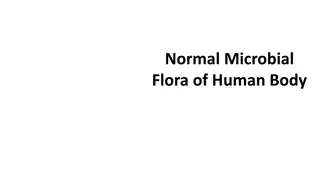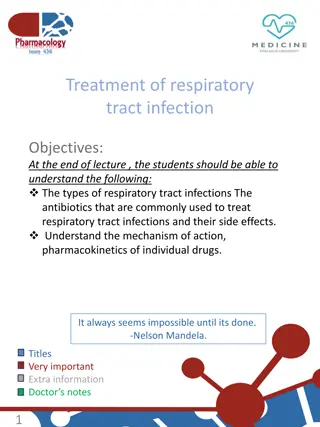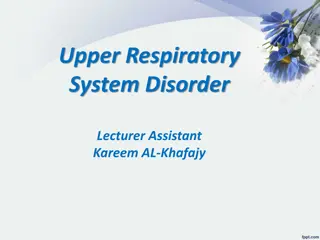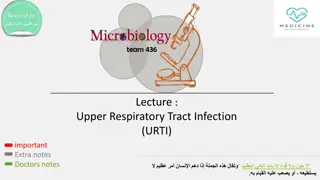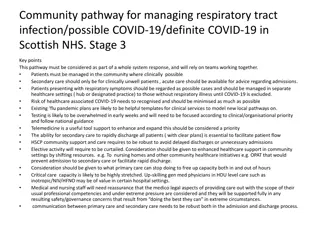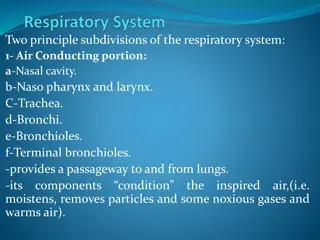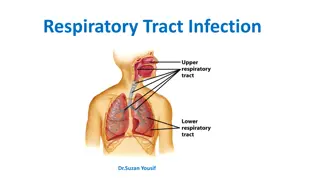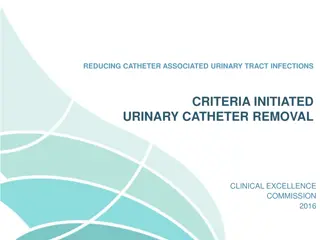Upper Respiratory Tract Infections: Clinical Features and Management
This presentation covers the differentiation between viral and bacterial infections, clinical features and management of sore throat, sinusitis including allergic rhinitis, otitis media in children, and modifying help-seeking behavior in patients with flu illness. Pre-test questions are also included to test knowledge on managing these infections.
Download Presentation

Please find below an Image/Link to download the presentation.
The content on the website is provided AS IS for your information and personal use only. It may not be sold, licensed, or shared on other websites without obtaining consent from the author.If you encounter any issues during the download, it is possible that the publisher has removed the file from their server.
You are allowed to download the files provided on this website for personal or commercial use, subject to the condition that they are used lawfully. All files are the property of their respective owners.
The content on the website is provided AS IS for your information and personal use only. It may not be sold, licensed, or shared on other websites without obtaining consent from the author.
E N D
Presentation Transcript
UPPER RESPIRATORY TRACT INFECTIONS Abdulrahman Alfawaz Abdulaziz almontshri Mohammed alqithmi
Objectives How can we differentiate between viral and bacterial infections? Sore throat (clinical features, differential diagnosis, complications, management) Sinusitis including allergic rhinitis (Clinical features and management) Otitis media in children (AOM and Secretory OM, Features, management) How can we modify help seeking behavior of patients with flu illness?
Q1 The most important step in managing allergic rhinitis is: Avoidance of allergy Usage for antibiotic for long time Drinking fresh orange juice Topical corticosteroid
Q2 3 year old child diagnosed with acute otitis media , what is the drug of choice to treat him : Amoxicillin Cephalosporin Macrolides Doxycycline
Q3 Ahmad is 30 year old gentleman complaining of headache increase on leaning forward during praying and mucopurulent post nasal discharge ,For the last 2 weeks . On examination, there was nasal discharge in both nasal fossae. What is the most likely? Acute Bacterial Rhinosinusitis . Acute Viral Rhinosinusitis Common Cold . Chronic Bacterial Rhino Sinusitis
Q4 A patient came in with sore throat, cough and low grade fever and muscle stiffness. After the doctor diagnosed her with her flu and prescribed her the treatment the patient asked the doctor what is the most common cause of sore throat. The doctor answered: Fungal Bacterial Viral Allergy
Q5 Mother brghout her chiled to the clinic complaining of mild earache mild deafness and there is no fever he was dignosed with acut otitis media . which stage of AOM this chiled have? tubal occlusion pre-suppuration suppuration
How to differentiate between viral and bacterial infection ? Bacterial infection. Discolored or purulent discharge (with unilateral predominance). A fever greater than 38 C. Severe local pain (with unilateral predominance). Elevated ESR/CRP (although the practicality of this criterion is limited). A marked deterioration after an initial milder form of the illness (so-called 'double-sickening'). Viral infection : Warty discharge
Case 3 year old female complaining of right earache, fever and decrease of hearing on the same ear. She had a history of URTI one week ago. What is the most likely diagnosis ?
Definition Acute otitis media (AOM) is Acute infection of the mucous membrane lining of the middle ear Secretory otitis media is Collection of fluid within the middle ear as a result of negative pressure produced by alterd eustachian tube function
Timeline - Acute OM < 3 weeks - Subacute OM 3 weeks to 3 months - Chronic OM 3 months or longer
Predisposing Factors Age (children) Gender (girls) Seasons (winter) Breast-feeding Smoke exposure Other Medical conditions
Route of infection Eustachian tube External auditory canal Blood borne
Etiology Bacteria:- S. pneumoniae - 30-35% H. influenzae - 20-25% M. catarrhalis - 10-15% Group A strep - 2-4% Viruses:- Respiratory syncytial virus (RSV) Rhinovirus Parainfluenza virus Influenza virus
Stages of AOM 1-tubal occlusion 2-pre-suppuration 3-suppuration 5-complication 4-resolution
1-tubal occlusion Edema and hyperemia of nasophargeal end of the eustachian tube block the tube absorbtion of air and ve pressure retraction and some degree of effusion Sign: Symptoms: 1- mild earach 2-mild deafness 3-no fever 1-tympanic membrane retracted 2-loss of light reflex 3- tunning fork show (CHL)
2-pre-suppuration If tubal occlusion is prolonged pyogenic organism invade Sign: Symptoms: 1-earach 2-deafness 3-tinnitus 4- fever 1-congestion and redness of the tympanic membrane 2-tunning fork (CHL)
3-suppuration 1-formation of pus 2-bulging of tympanic membrane Symptoms: 1- very sever earach 2-marked deafness 3-very high fever+vomiting Sign: Redness +bulging of tympanic membrane+loss of land mark
Note: 4-Resolution If the treatment is started early resolution may start without rapture of TM Rapture of TM release of pus subsidace of symptoms Symptoms: 1- earach is relived 2-pus discharge from the ear 3- fever comes down (child feel better) Sign: 1-small perforation in antero-infero of para tensa 2- return normal color and land mark of TM
5- Complications of OM : Intracranial : Meningitis Epidural abscess Brain abscess Cavernous sinus thrombosis Lateral sinus thrombosis Subdural empyema Carotid artery thrombosis
5- Complications of OM : Intratemporal : Hearing loss Balance and motor problems. TM perforation. Cholesteatoma Adhesive otitis media Extension of the suppurative process to adjacent structures (mastoiditis, petrositis, labyrinthitis)
Diagnosis Main Symptoms: Otalgia - Fever - deafness - facial paralysis -
Investigations When? Tests include: Tympanometry Tympanocentesis CT scans
Treatment 1.Observation, most cases resolve within 2-3 days 2. Symptomatic treatment with Paracetamol 3. Antibiotics undicated: - A child has a serious health condition that makes them more vulnerable to infection. - A child is under the age of three months - A child s symptoms show no signs of improvement after four days - Recurrent OM (Three or more attacks over a 6- months period)
Antibiotics** Amoxicillin : is the drug of choice - under 2 years, 125mg three times daily - 10 years, 250 mg three times daily - over 10 years, 500 mg three times daily However, Amoxicillin-clavulanate should be considered for patients with severe otalgia or elevated temperature to cover the possibility of beta-lactamase producing H. influenzae. If your child is allergic to amoxicillin, alternative antibiotics such as Erythromycin can be used
Case 35 year male came to PHC complaining of several episodes of headache associated with fever, nasal congestion and discharge, The headache concentrated in front of the head aggravated by bending forward. What is the most likely diagnosis ?
Definition Inflammation of the lining of the paranasal sinuses.
The maxillary sinuses are the most common site (85%), followed by ethmoidal (65%), sphenoidal (39%), and frontal (32%) involvement. 4th 1st 2nd 3rd
Classification Acute sinusitis < 4 Weeks Subacute sinusitis 4 Weeks and < 3 months Chronic sinusitis > 3 Months Recurrent acute sinusitis Diagnosed when 2-4 episodes of infection occur per year.
Etiology Infection Viral ( rhinovirus, influenza virus) Bacterial (Streptococcus pneumonia) Fungal ( Rare ) Cilia in the sinuses do not work properly due to some medical conditions (kartegner syndrome). Colds and allergies may cause too much mucus to be made or block the opening of the sinuses. A deviated nasal septum, nasal bone spur, or nasal polyps may block the opening of the sinuses.
Clinical Presentaion Day and night cough Purulent nasal discharge (v. imp) (diagnostic ) Nasal airway obstruction Headache, irritability, or facial pain Fever Postnasal drip.
Physical Examination Press over the air sinuses to check for: o Tenderness o Yellow to yellow-green nasal discharge. Check the inside of the nasal passages by torch to check the mucus and look for any structural abnormalities.
If signs and symptoms are not typical of sinusitis, rule out an alternative diagnosis . DDx o Allergic rhinitis. o Nasal foreign body. o Adenoiditis and tonsillitis. o Sinonasal tumour. o Other causes of facial pain or headache
Investigations Usually not necessary: o Diagnosis- Sinus Aspiration o Mucus culture o Nasal endoscopy o X-ray o Allergy testing o CT o Blood work
Management Abx - Amoxicillin/potassium clavunate (Augmentin) Erythromycin-sulfisoxazole Other Medications (facilitate drinage): Antihistamines if there is allergy Decongestants Anti-inflammatory agents ex. Steroids which will decrease the edema.
Non-pharmacological Humidifier to relieve the drying of mucous membranes associated with mouth breathing Increase oral fluid intake Saline irrigation of the nostrils Moist heat over affected sinus
Intracranial Complications 1. Meningitis (the most imp) 2. Epidural abscess 3. Subdural abscess 4. Intracerebral abscess 5. Cavernous sinus, venous sinus thrombosis
When to advise the patient to follow-up? I. II. If they develop a high temperature. III. Marked local pain that is predominately unilateral. If symptoms rapidly deteriorate.
Case Mr. Saleh a 35 year old Saudi gentleman came to the clinic complaining of pain in his throat for 4 days which is worse upon swallowing and talking. He also have runny congested nose and cough. What is the most likely dignosis?
